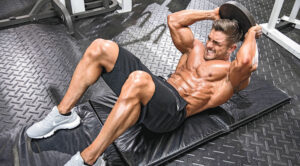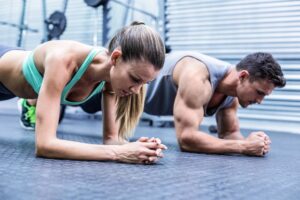The plank is a fundamental bodyweight exercise that strengthens your core, improves posture, and enhances stability. Its beauty lies in its simplicity – you don’t need any equipment, and it can be done almost anywhere. But don’t be fooled by its basic appearance – the plank offers a surprising amount of variety, allowing you to target different muscle groups and challenge yourself as you progress.
Strengthening the core is an important aspect of any workout regimen. A strong and solid core looks and feels good. But more importantly, it helps to stabilize, balance, and power the body during just about every other activity.
The plank exercises are excellent abdominal and core exercises. To ensure you keep your core strong and stable, add the plank to your ab workout program.
Core strength is the basis for all coordinated and powerful athletic movements. A strong core can reduce stress on the joints and allow you to achieve better posture.
The plank exercise can also be used as the basis for a core muscle strength and stability test. The plank is more of a strength-building exercise than a cardio exercise, but by engaging a range of muscles it can also help to boost your calorie burn.
Ranked as one of the top exercises that target the core, particularly the oblique abdominal muscles, “the plank exercise rises above the rest in simplicity, efficiency, and practicality. Planks are mentioned in almost every top 10 article discussing core muscle workouts. It does not require equipment or any other special contraptions to perform. If you have a body, you can do the plank exercise”.
The basic concept of the plank exercise is to assume a well-balanced (or isometric) stationary position while contracting certain muscles or muscle groups and holding it for a particular length of time. While the concept may seem simple, it has been proven to be very effective in exercising and strengthening your core muscles. The Transverse Abdominis, the muscles that lie deep beneath the obliques that wrap around your spine to protect it and give you stability; the Rectus Abdominis – extending along the front of your abdomen and is more commonly known as the “six-pack” muscles; the Erector Spinae or the muscles that run along your lower back up to your neck; the External Obliques or the “love handle” muscles around your waist; and the Internal Obliques which is located under the external obliques. These muscle groups are all involved in performing plank exercises properly.
This article explores the top 5 most effective plank variations you can incorporate into your workout routine, regardless of your location. So, ditch the gym membership (if you have one) and get ready to sculpt a strong core from the comfort of your home, park, or even your hotel room!

 Benefits of the Plank Exercise Positions
Benefits of the Plank Exercise Positions
But the benefits don’t end with these core muscles, as variations of the plank exercise are n fact total body workouts as they strengthen not only your midsection as described above but also your upper-body muscles (including the pectoral and serratus muscles) and lower-body muscles (such as the quadriceps, tensor fasciae latae and sartorius).
And as the plank exercise helps stabilize your hips and spine, it also improves your posture and helps prevent and even correct postural defects.
It is also a very efficient exercise for reducing stress. When muscles tighten and tension develops, exercise can stretch and relax them; and in the process, improve your mood and mental well-being. Finally, if you feel like you eventually will want to get into a more physically rigorous workout regimen, this exercise will strengthen your core and provide a stable platform to workout from. Which is always a good idea from a back safety and workout efficiency standpoint.
Convinced that you’d like to give it a try? Here are the top five basic yet very effective plank exercises people use every day to help get you started:
1. Basic Plank– Lie face down on the floor (use a mat or do this on a carpet or rug) as in a push-up position. Then bend your elbows and place your forearms closely on the sides of your chest down on the mat pointing forward. Using your forearms and toes, slowly raise yourself while keeping your whole body perfectly straight with no part of your body sagging or bending leaving only your toes and forearms touching the floor. Maintain this position initially for about 10 seconds, then increase the length of time in 10-second increments until you’re eventually able to do this for as long as two minutes. Remember to keep your head relaxed and facing the floor and to focus the tension around your midsection while doing this.
2. Basic Plank Variation – if you find it too hard to do the above basic plank exercise, start with this simple modified version: Instead of lifting yourself up with your forearms and toes, lift yourself using your forearms and knees instead. But as in the original version, remember to keep a straight line from your shoulders down to your feet to make this exercise work.
3. Leg Lifts – Using the same position, this time slowly lift one leg up about 7-8 inches off the floor, keep it up for two seconds then slowly put it down and do the same with the other leg. Do three sets with about 10 reps per set.
4. Arm Lifts – Again, from the original basic plank exercise position, slowly shift your weight on one arm and carefully lift the other arm, extending it in front of you for 2-3 seconds before slowly going back to the original position. Then repeat the same sequence with the other arm. If you’re feeling really adventurous, try the arm & leg lift.
5. Side Plank – Lay down on your side this time, with your elbow resting right beneath your shoulder and your forearm extended in front of you. Slowly and carefully lift your body on your elbow, still remembering to keep your whole body straight. Keep this position for about 10 seconds before slowly lowering yourself back to the floor starting at your hip. Repeat this sequence three times before switching to the other side of your body.
Mind your breathing when doing the above plank exercises. They work best with deep diaphragmatic breathing – inhaling deeply through your nose filling your stomach with air and slowly exhaling through your mouth.
These five basic plank exercises are a great way to introduce your body to this highly effective yet very simple exercise routine and are the foundation of any personal trainer’s core workout pyramid.
Check Out Our List Of The Best Supplements For Building Muscle, Shredding Muscle, Recovery, And Great Health, and Wellness Products! Purchase ifbnewsfeed.org‘s apparels Here: ifbnewsfeed.org

 Additional Top 5 Most Effective Plank Exercise Positions
Additional Top 5 Most Effective Plank Exercise Positions
1. The High Plank: The Classic Core Challenge
The high plank is the foundation for all other plank variations. Here’s how to perform it:
- Start in a push-up position with your hands directly under your shoulders and your body in a straight line from head to heels.
- Engage your core by pulling your belly button towards your spine.
- Keep your neck long and gaze slightly downward to maintain a neutral spine.
- Hold this position for as long as you can with proper form. Aim for 3 sets of 30-60 seconds for beginners, gradually increasing the hold time as you get stronger.
2. The Low Plank: Targeting Your Lower Core
The low plank offers a slightly different challenge by placing your forearms on the ground instead of your hands. This variation emphasizes your lower core muscles, including the rectus abdominus and obliques.
- Get into a push-up position, but lower yourself down onto your forearms, with your elbows directly under your shoulders.
- Keep your body in a straight line, with your core engaged and your back flat.
- Hold this position for as long as possible with proper form. Aim for the same sets and repetitions as the high plank.
3. The Side Plank: Sculpting Your Obliques
The side plank is a fantastic way to target your obliques, the muscles on the sides of your torso that help with rotation and stabilization.
- Lie on one side with your legs stacked on top of each other.
- Prop yourself up on your forearm, with your elbow directly under your shoulder.
- Engage your core and lift your hips off the ground, forming a straight line from your head to your heels.
- Hold this position for as long as possible with proper form, then switch sides and repeat. Aim for 3 sets of 30-60 seconds per side.
4. The Knee Plank: A Beginner-Friendly Option
The knee plank is a perfect modification for those new to planks or looking to ease back into them after a break. It reduces the intensity on your shoulders and core while still providing a solid core workout.
- Start in a high plank position, but lower your knees down to the ground.
- Keep your forearms stacked on top of each other and your core engaged.
- Hold this position for as long as possible with proper form. Aim for 3 sets of 30-60 seconds.
5. The Walking Plank: Adding a Cardio Twist
The walking plank is a dynamic variation that adds a cardio element to your core workout. It’s a great way to increase the intensity and challenge your core stability.
- Start in a high plank position.
- Engage your core and alternate bringing one knee towards your chest at a time.
- Move with a controlled and deliberate pace, keeping your hips low throughout the movement.
- Continue for a set amount of time or until fatigue sets in. Aim for 3 sets of 30-60 seconds.
 Frequently Asked Questions
Frequently Asked Questions
What muscles do planks work?
The plank exercise works the entire core, especially the rectus abdominis. It also works the abdominal muscles that run from the pelvis along the spine and up to the shoulder girdle.
How many calories does planking burn?
How many calories burned depends on your weight and how long you hold the plank. Typically, a 150-pound individual will burn about 3 to 4 calories a minute holding a plank.
What do planks help with?
Planks are great for building core strength and stability, which helps improve balance and coordination during everyday activities. A strong core can also support you during other forms of athletic or physical activity and can even help protect your lower back from injury.
Always Remember:
- It’s crucial to maintain proper form throughout all plank variations. Don’t let your hips sag or your back arch.
- Breathe normally throughout the exercise.
- Listen to your body and take breaks when needed.
- As you get stronger, increase the hold time or incorporate more challenging variations.
The plank is a versatile and effective exercise that can be easily integrated into your workout routine, no matter your fitness level or location. With these top 5 variations, you can sculpt a strong core, improve your posture, and build overall body stability – all from the comfort of your own space!
 More About The Most Effective Plank Exercise Positions Contents
More About The Most Effective Plank Exercise Positions Contents
- Build Up “A Chiseled Six-pack” With These Incredible 5 Abs Exercises
- “The Best Hanging Leg Raise Alternative Exercises” For Core Strength And Abs Developments
- This “5-Minute Abs Workout” Will Torch Your Core In The Best Way Possible. Try It
- Abs Development: Science Reveals “The Best (And The Worst)” Abs Exercises
- Abs Assault: Best Ways On How to Get a “6-Ripped And Shredded Pack Abs” Fast

- A1Supplements.com – America’s Favorite Supplement Store.
- Shop Optimum Nutrition Energy: Anytime & Pre-Workout
- A1Supplements.com – Lose Fat, Gain Muscle!







